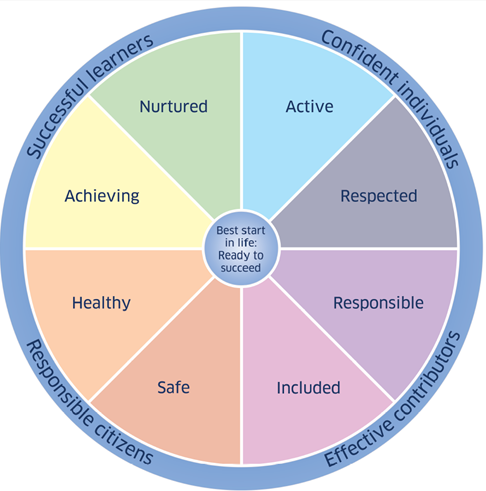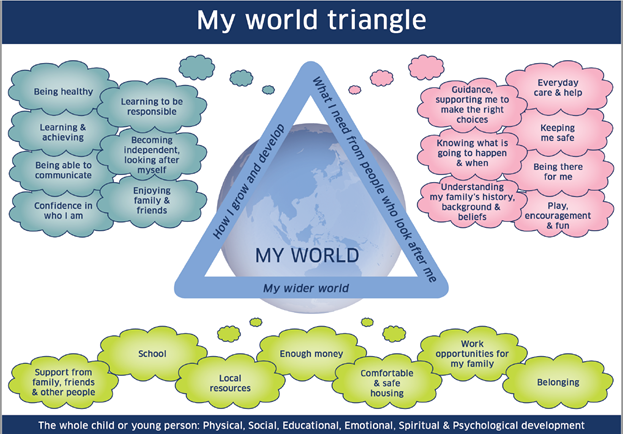Supporting disabled children, young people and their families: guidance
Guidance to help improve the experiences of disabled children, young people, and their families.
Disability in context
There is no place in Scotland for any form of prejudice or discrimination. Equality is about creating a fairer society where everyone can participate and has the opportunity to fulfil their potential. We believe that no child or young person should be denied opportunities.
This website uses the social definition of disability which assumes that people are not ‘disabled’ because of their diagnosis, condition or needs but because aspects of society, like public transport, schools or services often it difficult for them to participate fully and that they face barriers in their everyday life because of this.
We are committed to respecting, protecting and implementing human rights for everyone in Scotland and to embedding equality, dignity and respect in everything it does.
This means ensuring disabled children and young people understand their rights, and feel empowered to claim them, or to speak up when they feel those rights are not being upheld. We take a human rights based approach to policy which means ensuring that the standards and the principles of human rights are integrated into our policymaking as well as the day to day operations of support that disabled people access.
In this section you can find out about…
- Scottish Government Policy
- Getting it Right For Every Child (GIRFEC)
- General information about public services
- Multiple Discrimination
- Child Poverty and Disability
- Trauma: Adverse Childhood Experiences (ACEs)
Scottish Government policy
Disabled children and young people have access to the standard support and entitlements that apply to all families, as well as the additional support they need. There are lots of national policies that apply to families regardless of their additional support needs, but it would be impossible to capture all the policies that relate to health, parenting and education which families are already signposted to by other agencies like the NHS and schools.
Getting it Right For Every Child - GIRFEC
Getting It Right For Every Child is the national approach in Scotland to improve outcomes and support the wellbeing of our children and young people by offering the right help at the right time from the right people. The approach is underpinned by the United Nations Convention on the Rights of the Child. It is a way of working that empowers children, young people and parents by recognising and promoting their rights. This means putting their expressed needs at the heart of service development and delivery.
Most children and young people get all the help and support they need from their family and community, but sometimes, perhaps unexpectedly, they may need a bit of extra help. Getting it right for every child ensures they are able to access this additional support easily and without stigma.
The Getting it right for every child (GIRFEC) approach supports children and young people so that they can grow up feeling loved, safe and respected and can realise their full potential. At home, in school or the wider community, every child and young person should be:
- Safe
- Healthy
- Achieving
- Nurtured
- Active
- Respected
- Responsible
- Included
These eight factors are often referred to by their initial letters – SHANARRI.
They are wellbeing indicators which help make it easier for children and families and the people working with them to discuss how a child or young person is doing at a point in time and if there is a need for support.
Each child is unique and there is no set level of wellbeing that children should achieve. Wellbeing is influenced by children’s individual experiences and changing needs as they grow.
Different life circumstances can have negative effects on young people; including a broad range of adverse childhood experiences (ACEs) or where a family is affected by illness, disability or poverty. Each child should be helped to reach their full potential as an individual.
We have developed a series of wellbeing resources that practitioners can use or adapt for workshops or conversations with children, young people, parents and carers. These explain wellbeing, and how it is used to support children and young people, in more detail.
- Understanding wellbeing leaflet
- SHANARRI practitioner resources - wellbeing wheel, my world triangle etc
Wellbeing wheel

More information? The Scottish Government website maintains a wide range of information about the issues relating to children and young people.
My world triangle

General information about public services
Mygov.scot is the Scottish Government website which provides information about Scotland’s public services for all citizens. As outlined in the Scottish Government’s Digital Strategy, mygov.scot will be the single entry point for all services.
Information about laws, policies and the most up to date actions from the Scottish Government can be found on the website, Gov.scot.
Multiple discrimination
If we are to achieve our aim of full equality and human rights for disabled people in Scotland, then we must take account of all disabled people, including children and young people. We also have to understand how other characteristics such as age, sex, race, religion, sexual orientation, transgender identity or being a Gypsy Traveller can impact on a disabled person’s experiences and use this understanding to shape our actions.
It is important to recognise that people often experience disadvantage because of a combination of protected characteristics. As research by organisations such as the Equality Network indicates, this is not simply something encountered by a “minority of a minority”. Multiple discrimination is a part of many disabled people’s lives, and directly impacts on how they experience and respond to their disability.
What do I do if I am feeling discriminated against?
Disabled children, young people and their families should never expect to experience discrimination. This applies to interactions with public services such as claiming benefits or taking the bus, community life such as visits to the shops or leisure activities, in school and at work. In Scotland, there is an independent Equality and Advisory Support Service who give advice on any type of discrimination.
Child poverty and disability
Tackling child poverty is a key priority for the Scottish Government and statistics show that poverty is both a cause and a consequence of disability.
A broad range of actions have already been taken to try to address inequalities in our society: including free school meals for all P1- P3 children; expanding the funded provision of early learning and childcare; an improvement programme to address neglect and enhance wellbeing; and investing to mitigate UK Government welfare reform and support low income families.
The Child Poverty (Scotland) Act 2017 underpins all Government action, and holds Scottish Ministers to account for their efforts in tackling poverty. The first Child Poverty Delivery Plan was published in March 2018, and will seek to take a cross-Government approach to reducing child poverty.
This resource supports the Poverty Delivery Plan by helping families to be more aware of Financial Support available to them to assist with the financial implications of caring for a disabled child. Similarly, the Delivery Plan specifically identifies disability as a key area for the Scottish Government to continue to target support measures. Only through such coordination will we effectively remove those barriers which prevent families from moving out of poverty.
Where can I find out more about poverty and inequality in Scotland?
The Scottish Government has established a Poverty and Inequality Commission. The Commission will provide independent advice and scrutiny on Government targets and Delivery Plan, as well as wider economic inequalities, and openly hold Scottish Ministers to account on their progress.
Adverse Childhood Experiences
The term adverse childhood experiences (ACEs) refer to stressful or traumatic events occurring in childhood and adolescence (between 0 to 18 years). There are some key, commonly measured ACEs, including: different types of abuse and neglect, parental separation, and growing-up in a house where there are adults experiencing alcohol and drug use problems, mental health conditions, domestic violence, or imprisonment. There are also other types of childhood adversity that can also have similar impacts, such as bereavement, bullying, and community adversity (e.g. neighbourhood violence). It is also well known that growing up in poverty can also lead to long-term impacts on health and well-being and life outcomes. The Scottish Government is committed to addressing all types of childhood adversity which impact on children’s healthy development.
Why is it important to address ACEs?
Stressful or traumatic experiences can create harmful levels of stress which can impact children’s development and potentially result in long-term effects on learning, behaviour and health. ACEs can increase the risk in later life of adopting health harming behaviours, developing mental and physical illness, or negatively impacting education and employment outcomes. It is not pre-determined that ACEs will lead to such negative consequences, but without intervention, experience of childhood adversity can increase the risk of such outcomes.
ACEs occur across all income and social groups, so we need to be concerned about childhood adversity and trauma across the whole of society. However, we need to pay particular attention to how discrimination and inequalities in society (e.g. relating to disability, ethnicity and income) influence the levels of childhood adversity experienced and people’s ability to overcome such experiences.
What is the government doing to address ACEs?
The Scottish Government is taking forward actions across all Government departments, and in conjunction with partner organisations, to better prevent ACEs occurring, and where they do to help reduce the negative impacts and support the resilience of children and adults affected. The Government is taking forward four areas of action on ACEs:
- Providing inter-generational support for parents, families and children to prevent ACEs (e.g. perinatal and infant mental health support, increasing health visitor numbers, tackling child poverty)
- Reducing the negative impact of ACEs for children and young people (e.g. provision of school nurses and counsellors, supporting children affected by domestic abuse, supporting contact between parents in prison and children).
- Developing adversity and trauma-informed workforce and services by working with NHS Education for Scotland to implement a Scottish Psychological Trauma and Adversity Training Plan
- Increasing societal awareness of the importance of preventing and addressing ACEs and supporting action across communities.
Where can I find more information on ACEs?
The Scottish Government website has information about ACEs. The NHS Health Scotland are working with a group of professionals, called the Scottish ACE Hub, to take forward actions to prevent and respond to ACEs. The NHS Health Scotland webpages on ACEs provides an animation explaining ACEs and details some of the work they are doing to develop evidence and actions on ACEs. NHS Education for Scotland webpages also provides information about plans for implementing trauma training across the Scottish workforce and an animation explaining what a trauma-informed approach is.
There is a problem
Thanks for your feedback